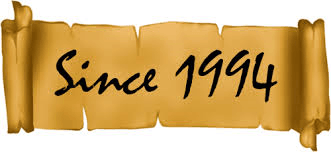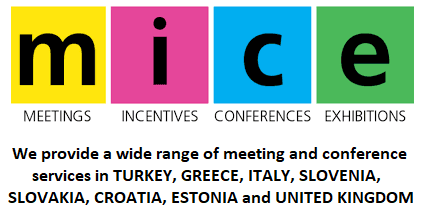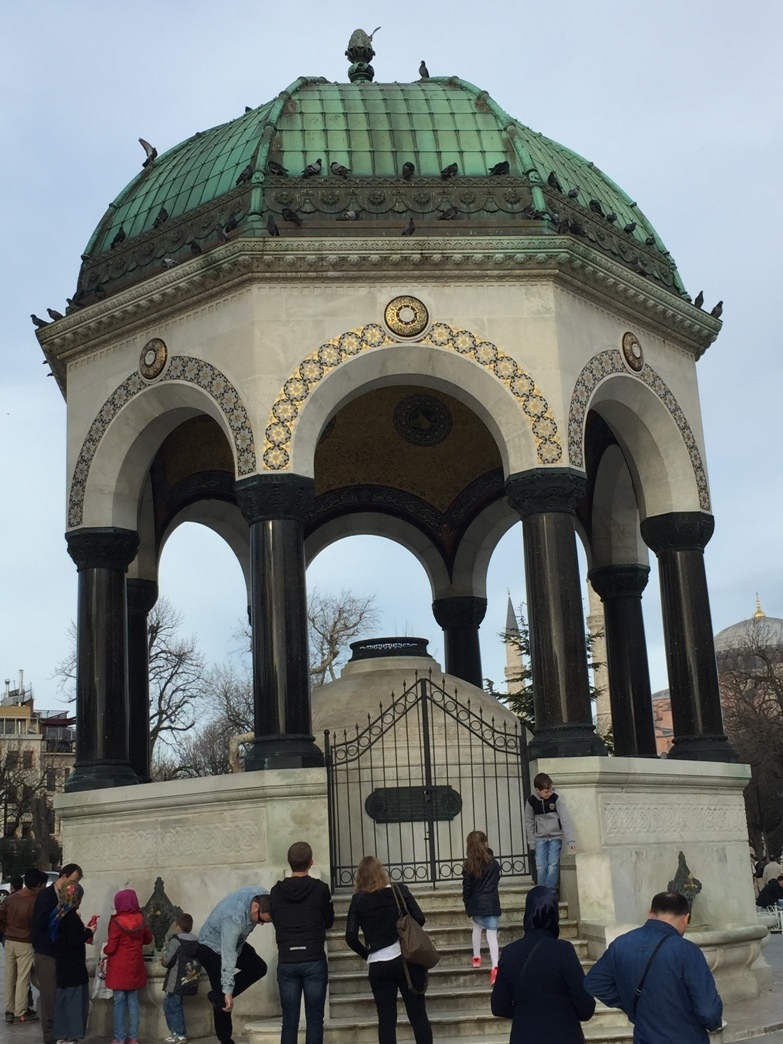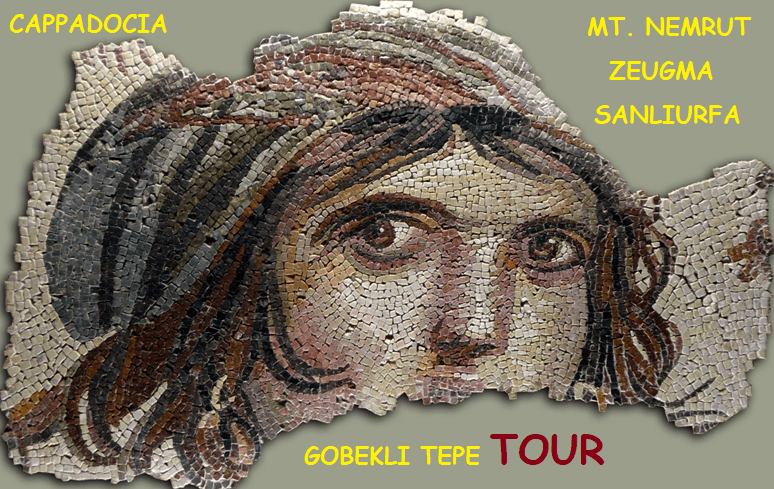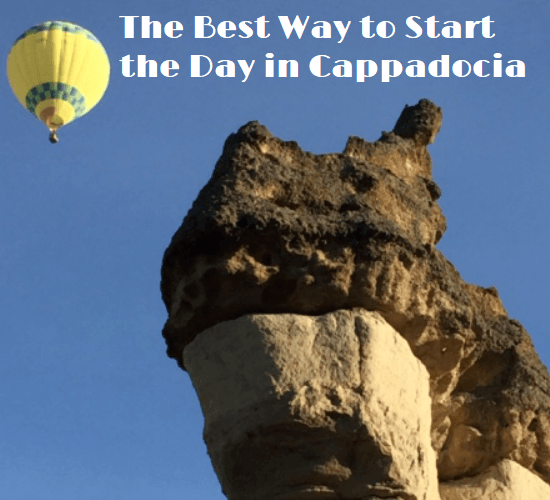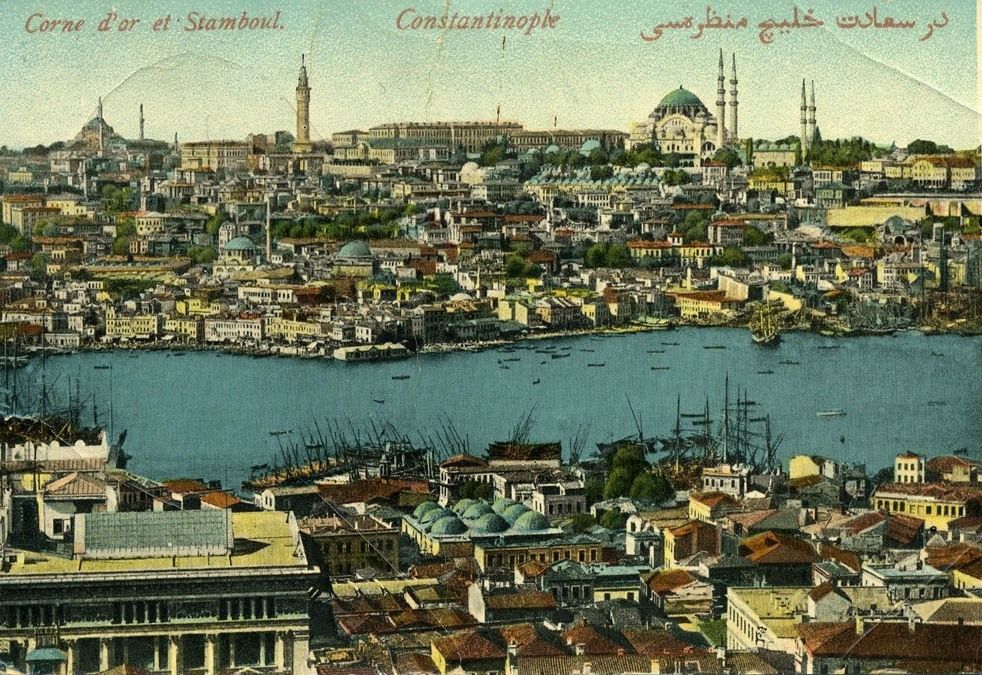
From the book “I am Istanbul” by Buket UZUNER
“I am Istanbul, city of cities, mistress of metropolises, community of poets, seat of emperors, favorite of sultans, pearl of the world! My name is Istanbul and my subjects call themselves “Istanbullu”. And of all the world’s cities, I am without doubt the most magnificent, mysterious and terrible, a city upon whose shores Pagans, Christians, Jews, and unbelievers, friend and foe alike, have found safe harbor through the ages, a place where love and betrayal, pleasure and pain, live side by side.
I, daughter of Poseidon, miracle of Argonauts, Empress of Medieval Cities, the harbinger of a New Age, whose star shines anew in the 21st century, am the city of prosperity and ruin, of defeat and glad tidings. Istanbul is my name. It is I! Place of extremes, the full gamut of human emotions experienced at one and the same time, from the sublime to the basest, the loftiest to the lowest. I! My name is Istanbul, eternal archangel and goddess of cities. They come and go, leaving their mark on my soul. I have seen them rise and fall, be born and decline; I harbor their jumbled relics in my underground cisterns and vaults.
Blue as hope, green as poison, rosy as dawn, I am Istanbul; I am in the Judas tree, in acacia, in lavender; I am turquoise! I am the unfathomable; the muse of possibility, vitality, creativity.
My name is Istanbul. That’s what they call me, what they have been calling me for a century past; but I have been Constantinople, city of Constantine; I began as Byzantium, and have had many names since: The Gate of Heavenly Felicity, Dersaadet, Dar’üssadet, New Rome, Asitane, Daraliye, He Polis, Tsargrad, Stamboul, Konstantiniyye … Mortals are like that, forever changing names, laws and borders! I laugh at these mortals taking themselves so seriously in their fleeting mortal world of false illusion, fears and shadows. Had anyone thought to consult me, I would have chosen “Queen of All I Survey”, which is what I am, anyway. I am Queen of Queens, City of Cities; I have walked with emperors and sultans, shared the confidences of travelers and poets. Aspiring authors still line up to write about me. In fact, here comes one now!”
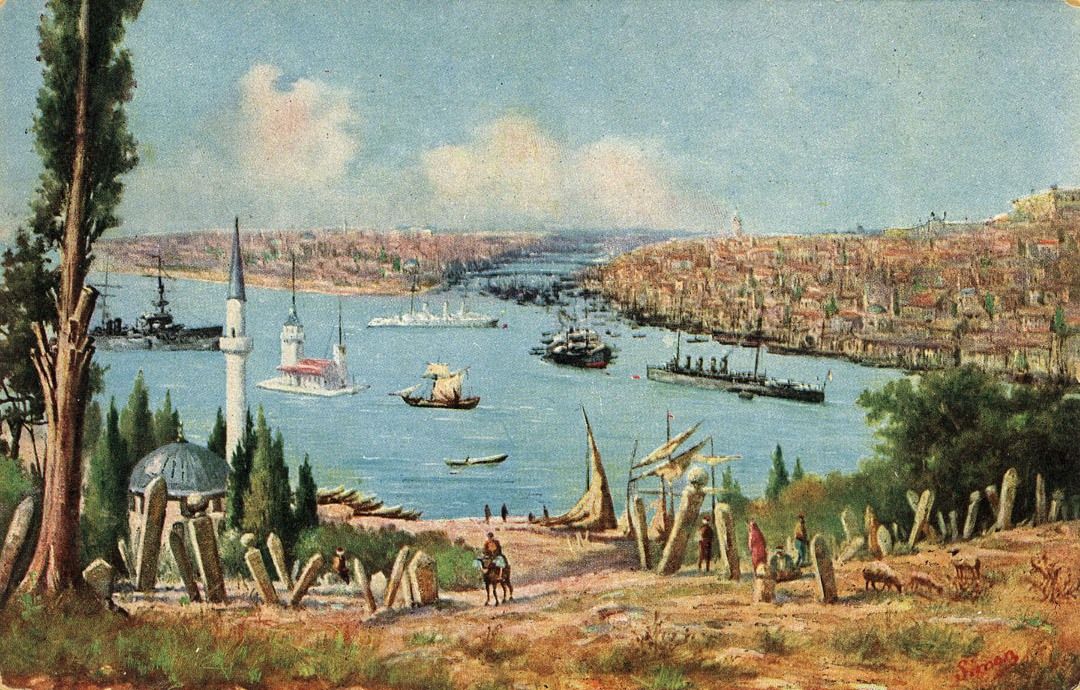
Istanbul Guide
Istanbul is the only city in the world spanning two continents. The main part of the city in the European continent is separated from the suburbs in Asia by three bridges and an underground tunnel. The European city is also divided into two by the Golden Horn with the old imperial town on one side bounded by the ancient Propontus (Marmara Sea) and port quarter of Galata on the other side along the shores of Bosphorus.
The city of Constantinople was situated on a fortified peninsula surrounded by the sea. There were battlements and moats along the 21-kilometer walls, which made the city invulnerable over centuries.
History
According to Strabo, the Greek geographer from Amasya in today’s Turkey who lived 64 B.C.-A.D. 24, the city was founded on the Acropolis (Sarayburnu) in the seventh century (Around 667) B.C. by colonists from Megara (A Dorian city in Greece), led by Byzas, though it is known that the area had been inhabited much earlier than that. In fact, 2004 excavations during the construction work of rail and subway network that linked Europe and Asia via a tunnel under the Bosphorus revealed a 4th century port in Yenikapı where 8000-year old artifacts were unearthed.
That port that is dated to the reign of Theodosius I was active until around 1200. The wrecks, ships, bones and artifacts covered in that area are well preserved due to the silt from the Lykos River (Bayrampaşa Deresi) and sand from the Marmara Sea. Most of the findings in this area are on display in the Archaelogical Museums of Istanbul.
According to the legend, before coming to Istanbul, Megarian leader Byzas went to oracle in Delphi to ask his advice as to where to make their settlement. The answer was a location in Istanbul “across the city of the blind”. They came and saw an earlier settlement in the Asian side, Chalcedon, today’s Kadıköy. They concluded that these people were indeed blind as they settled there instead of such a beautiful place where they settled now. They named their city as Byzantium after their leader’s name “Byzas”.
Thanks to its strategic position the city soon became the center for trade, especially for its wine and fisheries.
Like the other Greek cities on the edge of Asia Minor, the city experienced the Persian invasions under Darius in 513 B.C. and was absorbed in the empire of Alexander the Great, and was involved in the struggles following the dismemberment of that empire and the subsequent eastward expansion of Rome. By the first century B.C., Byzantium had become a client state of Rome by enjoying some three centuries of prosperity under the wings of Pax Romana.
By the end of the 2nd ce”ntury a civil war broke out and the city was besieged and torn down by the Emperor Septimus Severus in 196 A.D. A few years afterwards, the Emperor realized the strategic importance of the city and then he rebuilt the city and its walls - the portion between the Galata Bridge and the lighthouse in Marmara.
At the beginning of the 4th century, in 305, following the retirement of the Emperor Diocletian, the co-emperors, the successors in the Tetrarchy, fought each other to control the Empire. Constantine, the Emperor of the West eventually defeated Licinius, the Emperor of the East, on the hills above Chrysopolis (Üsküdar) in 324 and became the sole ruler of the Roman Empire. The city then underwent a comprehensive building program which made it five times larger than that of Septimus Severus and became the capital of the Empire in 330 with its new name as Constantinople - the city of Constantine. Shortly after this Constantine I allowed Christianity to be practiced publicly.
In the first half of the 5th century - during the reign of Theodosius II, a new and stronger defense walls were built on the direction of Thrace. These walls have delimited the size of the city with the seven hills, the same number as in old Rome. Six of the seven hills that are crowned with a Byzantine church or an Ottoman mosque can be seen from Galata Bridge. Here they are:
1. Seraglio Point (Hagia Sophia, Blue Mosque, Topkapi Palace)
2. Nuruosmaniye Mosque, Grand Bazaar, Column of Constantine
3. Istanbul University, Süleymaniye Mosque, Beyazid II Mosque
4. Fatih Mosque, Balat
5. Mosque of Yavuz Sultan Selim
6. Edirnekapı, Ayvansaray
7. Topkapı, Aksaray,Yedikule (Cannot be seen from Galata Bridge).
After the death of Theodosius I in 395, the Roman Empire was divided into two as Western and Eastern (Byzantine[1]) Roman Empire. The former one under Honorius was Latin while the latter one under Arcadius with the capital in Constantinople was Hellenic. Following the overrun of the western part of the Empire by the barbarians in 476, the Emperor in Constantinople remained the sole ruler of what was left of the Empire. The Eastern Romans adopted Christianity by changing their language from Latin to Greek. This brought about a profound change in the nature of the Empire then with the largely Greek-speaking Christian population.
Justinian the Great succeeded to the throne in 527, but he was almost overthrown due to the insurrection of the fractions (Blues & Greens) in the Hippodrome, known as Nika Revolt, in 532. During his reign, many of the lost dominions of the Roman Empire were reconquered with the borders from Euphrates to the Pillars of Hercules (Strait of Gibraltar). After the death of Justinian in 565, the Empire was exposed to assaults of Lombards (Germanic people in Italian Peninsula), Slavs (People of eastern Alpines), Avars (Eastern neighbor of the Lombards) and Persians while it was also ravaged from within by anarchy, plague and social unrest. Emperor Heraclius who ruled from 610 til 641 was able to defeat the Persians, the Avars and the Slavs. Shortly after his death, eastern parts of the Empire were overrun by the Arabs, though. In 813 and 913, large areas in the Balkans were invaded by the Bulgarians, but they could not pass over the Theodosian walls of Constantinople.
Despite these invasions, Byzantine Empire was still strong with the borders stretching from southern Italy through the Balkans and Asia Minor to western Persia. However, after having been defeated to Seljuk Turks at the battle of Manzikert in 1071 a great deal of the eastern Asia Minor was lost. The same year Normans (People from France with Viking descent) also captured Bari bringing to end Byzantine rule in Italy.
A decade after these defeats Alexius Comnenus ascended to the throne in Byzantium in 1081. During his reign, the Empire was subjected to increasing pressure of Latins of Western Europe. First of these armies - First Crusade - passed through Asia Minor in 1097. In 1203, the armies of the Fourth Crusade, supported by Venice, attacked upon Constantinople. Though they were unable to take the city at that time they again came next year and breached the seawalls along the Golden Horn on April 13, 1204. They ruined and sacked the city by demolishing libraries and world famous works of art. They were interested in only gold, silver and money. Baudouin de Flandre, the leader of the crusade, was crowned as the Latin Emperor in Hagia Sophia. The Latin kings ruled in Constantinople from 1204 to 1261, which it was recaptured by Michael VIII Palaeologus who restored the Byzantine (Eastern Roman) Empire again.
However, Byzantium never fully recovered from this catastrophe and the Empire then remained only a fragment of what it had been in former days, with only some areas in Thrace, Macedonia and the Peloponnesus (Mora) along with Constantinople while its lands had been occupied by the Latins and Ottoman Turks. Next century Turks crossed over into Europe and advanced far into Balkans. By the 15th century, Byzantine Empire consisted of little more than Constantinople and its immediate suburbs.
It was eventually sieged by Sultan Mehmet II (The conquerer), the Ottoman Sultan, where he dragged the warships on a wheeled platform up and over the hills of Pera and down into the Golden Horn to bypass the iron-chain barring the mouth of Golden Horn. Thus, after seven weeks the city was captured by the Ottomans on May 29, 1453, while the last Emperor, Constantine XI Dragases, also lost his life in the battle.
Constantinople became the third capital of the Ottoman Empire while the Sultan repopulated the new Moslem town with Turks, Greeks and Armenians from Asia Minor and Thrace. In 1492, large numbers of Jewish refugees from Spain were welcomed to the Empire by Beyazıt II, the son and successor of Sultan Mehmet II.
Further to the defeat of Ottomans at the World War I, Istanbul remained under the occupation of Great Britain from November 13, 1918, to October 4, 1923. However, the War of Independence was finally won by Turkey under the leadership of Atatürk and the new Republic of Turkey was formally established in October 29, 1923, following the abolishment of Sultanate. Ankara was chosen as the capital of the new state.
The city went through several name changes during the Ottoman rule as Konstantiniye, Polis, Stimpol, Estanbul, Istambol and Islambol. After the conquest of Constantinople the coins minted in the city bore the name of “Konstantiniye” and remained so until the last Sultan Vahdettin’s rein (Below is a silver coin minted during the reign of Vahdettin and the name “Konstantiniye” is written on the marked section).
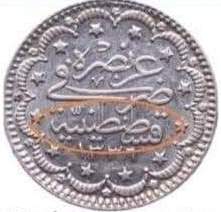
The names “Istanbul” or “Islambol” were used by the ordinary people while Saltanate members, ulama and intellectual circles preferred to use the names like ““Konstantiniye”, “Dersaadet, etc. Eventually, the name was officially changed to Istanbul in 1929. However, the mails coming from abroad still bore the name of Constantinople. Therefore, Ataturk declared that any envelopes bearing the name of “Constantinople” would not be accepted by the Turkish Postal Administration.
[1] The Byzantines never called themselves as Byzantines, but Romans. The name “Byzantine Empire” was begun to be used by the historians after the 18th century.
Blue Mosque (Sultan Ahmet Mosque)
Visiting Hours:
A functioning mosque and therefore visitors are accepted only when there are no prayers
Daily except Fridays
08:30-11:45
13:15-14:45
15:45-17:00
On Fridays
13:30-14:45
15:45-17:00
Admission Fee
Free
Sound & Light Show
Available at 21:00 on some summer evenings
Ottoman Sultan Ahmet I[1] (1603-1617), who liked the location of the Mehmet Paşa Palace owned by Ayşe Sultan, purchased it and ordered a large mosque to be built. The construction of the edifice began in 1609 and finished in 1616. The architect was Sedefkar Mehmet Ağa, the chief architect of the Sultan and one of the apprentices of Architect Sinan as well as being a skilled inlayer of mother-of-pearl and a talented musician. Eventually, one of the most splendid of the imperial mosques that incorporated Byzantine architecture with that of traditional Islamic in the city was created.
The plan of the mosque is close to being square covering an area of 64 x 72 meters. The inner courtyard is also square and together with the mosque itself, it forms a rectangle. The interior of the mosque is 51.65 / 170n ft in width and 53.40 m / 175 ft in length.
The outer courtyard has five doors.
[1] Sultan Ahmet I who succeeded his father Mehmet III in 1603 was the 14th Ottoman Sultan. He was crowned when he was 14 years old and he reigned 14 years. He was known for his skills in poetry through which he used the name “Bahti” on his political and lyrical works, horseback riding and fluency in English. He was one of the most devout Moslem sultans supporting the works of scholars and pious men. He attempted to enforce Islamic laws and traditions, prohibited alcohol, attempted to enforce attendance to the Friday noon-time prayers and paying alms to the poor. He died of typhus in 1617; only one year after his mosque was completed.
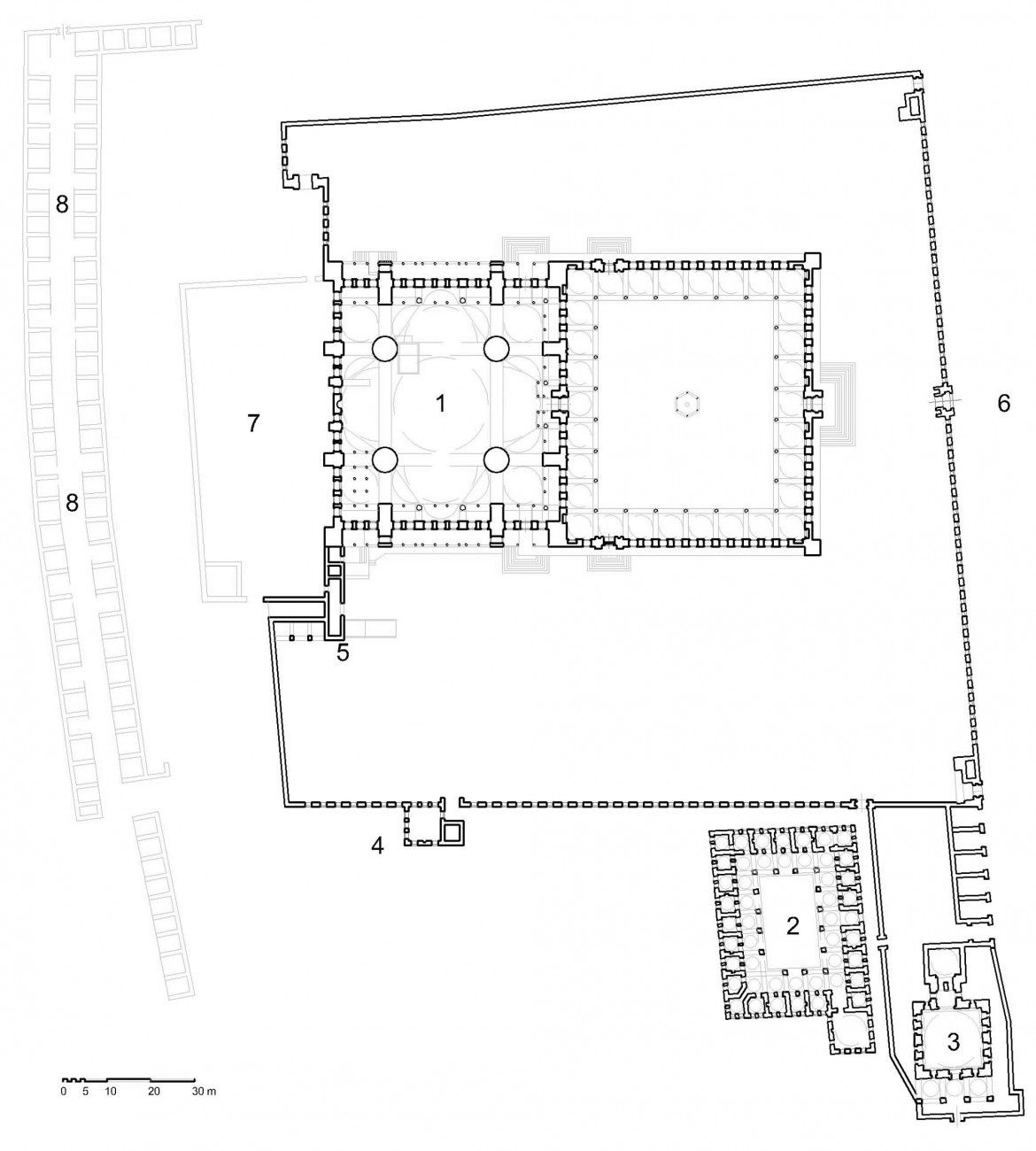 |
1. Mosque 2. Madrasa 3. Mausoleum 4. Elementary School 5. Royal Pavillion 6. Hippodrome 7. Garden Platform 8. Arasta Bazaar |
The main gate is on the Hippodrome side. From here, one arrives into the inner courtyard. The inner courtyard in the classic style with the porticoes around has one door in the front and two at the sides. The monumental bronze doors of the courtyard were made by the jeweler Zilli Çelebi. A few marble steps lead to these doors.
The arches of the inner courtyard are surrounded by a peristyle (row of columns surrounding a courtyard) that has different proportions from those at classical mosques (Those built around 1501-1703). This portico has 30 domes that rest on 26 granite, marble and porphyry (reddish granite) columns.
The handsome ablution fountain in the interior courtyard has six corners (octagonal) with marble columns. The arches are decorated in the Ottoman style with dovetails in relief. The angle irons are decorated with tulip and carnation designs in relief. This is only symbolic while the actual ones are outside on the walls of the inner courtyard, on the northern and southern sides.
The mosque has six slender minarets with the gilded ornaments and flutes accenting the corners of the courtyard, four of them with three balconies on each and two of them with two balconies on each, making sixteen balconies. There are three entrances to the main building being the one on the south is for the visitors, the one on the west is for the prayers and the one on the north is for exit of the visitors.
The central dome of the mosque, of 22.40 m / 73.5 ft in diameter and 43 m./ 141 ft high, rests on four big semi-arches, placed upon four big “elephant’s feet” (pillars carrying the dome), which are 5 m / 16.4 ft in diameter. On the four sides, there are semi domes flanked by smaller ones and supported by exedras. Thus, apart from that of Hagia Sophia, it has a quatrefoil design; or in other words, a centralized plan, which has two disadvantages as the reiterated symmetry makes is lifeless and tedious due to the prominence given to the bulky piers that support the dome.
The niche - the apse -(the “mihrab” that indicates the direction of kıble / the holy city of Mecca, toward which the faithful must face whilst performing their prayers) of the mosque in the center of the wall opposite the main entrance exhibit a beautiful marble workmanship. To the right of the mihrab is the mimber (pulpit), where the imam stands whilst delivering his sermon at the time of the noon prayer on Fridays and other holy days. The pulpit is made of Proconnesian (gray) marble like mihrab.
On the left side of the mihrab is the high cushioned platform, where the imam sits when he reads the Quran to the congregation. Against the opposite pier on the right is muezzin mahfili, a raised marble platform where the muezzin carries out his duties to call for prayer and chants in response to the imam’s prayers. This section may not be found in all the mosques, as it is not a mandatory requirement for a mosque.
The sultan’s loge at the far corner of the left gallery has a niche decorated with mosaics and jades, a door of mother of pearl and gilded tiles. There are reliefs and carvings on the banisters. There are two accesses to the loge, from the mosque or from the imperial pavilion. This is the loge where Sultan and his party sat when they attended services. The imperial pavilion is the earliest example of its kind. Sultan would enter it via a ramp when he came on a horse. He rested in this place before or after the prayer.
The mosque is especially known for its beautiful turquoise blue tiles in abundance, which is why the mosque is also named as Blue Mosque by the foreigners. All the interior walls and one third of each column are covered by tiles. The tiles on the lower part of the walls, especially in the galleries, are the original ones. The 21.043 tiles on the big panels of the walls belong to the 16th and 17th centuries. They were produced in Iznik (Nicaea[1]) according to more than 50 different designs made by master artists at the Palace, especially by Master Hasan, the tile maker. Their background is white and they are decorated with subtle blue, green, red, turquoise and black colored flowers such as tulips, lilies, hyacinths, roses and carnations as well as trees like cypresses along with branches woven around intricately.
The chisel gravings and ceiling decorations of the mosque are made of bronze, wood and mother of pearl.
The interior of the mosque is illuminated with its 260 windows in five rows from top to the bottom. The old windows of the stained glass that had once tempered too-crude lightness were removed and replaced with the ordinary glass imitations at the expense of detracting the beauty that the tiles and the carpets had in soft light. The painted arabesques in the domes and upper parts of the building are also less good than the original ones that were richly elaborate in design and somberly magnificent in color. The idea behind these replacements was that the former ones had detoriated with age.
The inscriptions as well as the mother of pearl work were done by Ahmet Gubari, the Calligrapher.
The complex also consisted of philanthropic institutions like a public fountain, a madrasa (theological school) with 24 cells and classrooms around a rectangular courtyard outside the precinct wall toward the northwest, near the mausoleum, a caravanserai, arasta, the only open-air bazaar selling equestrian products dating back to the 17th century, on the eastern side, and a primary school (elevated above the northern wall of the outer precinct of the mosque, on the left side of the imperial pavilion, mostly for religious education). The caravanserai was destroyed in the 19th century. The soup kitchen and the hospice, on the other hand, are now incorporated into the building of Marmara University Administration Building, situated at the southern end of the Hippodrome.
The mausoleum of Ahmet I was built during the reign of Sultan Mustafa (1617-1618). In the mausoleum, there are tombs of Ahmet I, founder of the mosque, his wife Kösem Sultan, and three of Sultan Ahmet’s sons; Murat IV, Osman II and Prince Beyazit (The hero on Jean Racine’s tragic work “Bayazıt” in 1672) along with Ahmet’s grandchildren.
Sultan Ahmet willed in his deed of trust that the Nativity Poem of the prophet be chanted in this mosque on the birthday of the prophet. Since then this poem has been chanted in the mosque during important ceremonies.
In the olden days, holiday processions used to start from this mosque and the sultans performed their holiday prayers in the sultan’s loge within.
[1] Nicaea was an important commercial and cultural center following Hellenistic and Roman Kingdom of Bithynia rules. Two ecumenical councils convened here during the Byzantine period. Under Ottomans, its name was changed to Iznik, becoming the largest tile production centre with some 340 ateliers. When a new building was built the Sultan contacted the governor of Iznik, who distributed the work to the ateliers. Tiles used for interior decorations were 24x24 cm / 9.45x9.45 inch and 2-3 cm / 0.7-1.2 inch thick. The earlier motifs on the tiles were blue, dark blue and yellow colors on white background while the later works had more motifs and color combinations. Certain shade of coral disappeared on the works of the 17th century works, probably due to the death of its master.
Chora (Kariye)
The word “Chora” means land, country or a suburban area and the edifice was named as “Chora” as it was located in the countryside outside the city limits.
It is thought that there was a chuch or monastery in the same location before the erection of the land walls of Theodosius II in 413 AD. The first Chora was erected on the same area in the early 7th century and it probably survived the Iconoclasm (726-843) like other many churches and monasteries.
The church was rebuilt by Maria Ducena, the mother-in-law of the Emperor Alexius I Comnenus, in 1080s.
It suffered from the Forth Crusade (1204-1261) during which Latins occupied Constantinople.
After the reestablishment of the Byzantine rule in 1261, the church gained importance and served as one of the two principal churches of Constantinople together with Hagia Sophia.
Theodore Metochites (1269-1332), who served as the Prime Minister of Emperor Andronicus II Paleologus, restored the Chora in 1321.
The church was transformed into a mosque in 1510 by Atik Ali Pasa, the Grand Vizier of Sultan Beyazıd II (1481-1512)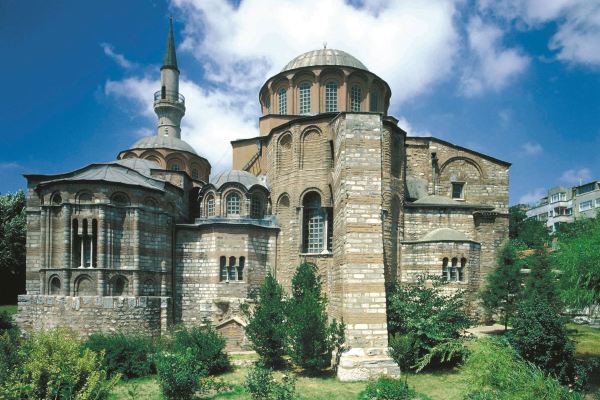
The mosaics in the Chora can be divided into three major goups:
1-Separate panels showing the angels, saints and imperial people
2-The panels in the inner narthex, related to the life of Virgin Mary
3-Life and miracle cycle of Christ in the walls and ceiling of most of the outer narthex
Grand Covered Bazaar
The foundation stone of Grand Bazaar, one of the greatest and oldest bazaars of the world, was laid over a Byzantine trade center in the 15th century by Sultan Mehmet II and then more parts were added when people needed more spaces in the following centuries. The complex was exposed to earthquakes and fires for a few times, but thereafter it underwent restoration. As in the Ottoman times, today more than four thousand shops, which spread over an area of 30 hectares, congregated together to sell the same kind of merchandise.
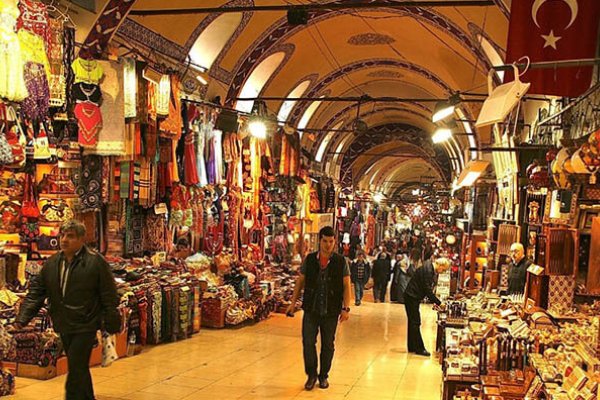
Hagia Sophia
Hagia Sophia, with its fourth largest dome in the world after St. Paul’s in London, St. Peter’s in Rome and the Duomo in Florence, represents the Christian mysticism in the middle ages and this was the place where emperors were crowned and victories were celebrated. It remained as the largest shrine for a long time in the past. The church was dedicated as Hagia Sophia, which means Divine Wisdom, an attribute of Christ.

The architects of the edifice were from Anatolia: Anthemius of Tralles (Aydın), an engineer and a mathematician, and Isidorus of Miletus, an architect. One hundred master builders supervised ten thousand workers in its construction.
The first church of Hagia Sophia (Divine Wisdom) was dedicated in 360 AD during the reign of Constantius, son of Constantin the Great, though there are also few sources claiming to be built during the reign of Constantine the Great. This building was burnt in 404 during a revolt that protested the exile of Patriarch John Chrysostom by the Empress Eudoxia, wife of Emperor Arcadius.
The second church was built by Theodosius on the ruins of the first one in 415 and remained intact until Nika Riot in 532. The riot started in the Hippodrome during the chariot races. While Justinian the Great was not the legitimate heir to the Byzantine throne he had made Theodora, a circus actress, the queen. He had also been surrounded by the corrupted courtesans. After the Blues joined the discontent Greens, demonsrations and riots started and lasted for a week, during which the second Hagia Sophia and the neighboring Hagia Irene along with many other public buildings were put on fire. However, as a result of an intrigue the Blues were separated from the Greens and and then Justinian’s general Belisarius entered the Hippodrome with his Goth mercenaries and killed some 35.000 Green Partisans as well as some Blues ones.
Today’s Hagia Sophia is the third edifice that was built in 537 by Emperor Justinian. The figural mosaics of the church were destroyed during the Iconoclastic Period, which lasted from 726 to 843, and therefore, those what we see today are from after that period though there are different views with regards to the dates among the experts.
The building has a classical basilica plan, the main floor of the building being a rectangle (70 m / 230 ft in width and 100 m / 328 ft in length). Four large piers separate the central space from the side aisles. There are 107 coumns in total, 40 of them at the lower floor while 67 of them are at the upper floor. The dome is 55.60 m / 182 ft high. The dome is slightly elliptical with a diameter of 31.20 m / 102 ft. on one axis and 32.80 m / 108 ft. on the other.

Hagia Sophia was converted to a mosque after the conquest of Constantinople in 1453. Theerafter, it was converted into a museum in 1934 though its status was changed again in 2020, which now serves as a mosque while the visitors are still welcomed.
The Hippodrome
The Constantine Column is a monolith column built of stones at a time we do not know exactly. However, we know from its inscription that it was restored by Constantine VII Porphyrogenitus and his son Romanus II in the 10th century.It is 32 m / 105 feet high. At the bottom there is a marble base over which there are three steps. It is though that some of the pieces plundered during the 4th Crusade in 1204 were used in St. Mark’s Square in Venice.
The Serpent Column was a huge bronze with three entwined serpents that had been erected before the Apollo Temple in Delphi to celebrate the victory of 31 Greek cities against Persians in the 5th century BC. It is 5.30 m / 17.4 ft though its original size was 8.00 m / 26.30 ft high. It was brought to Constantinopolis in the 4th century. A piece of one of the serpent heads is being kept in Istanbul Archaelogy Museum.
 |
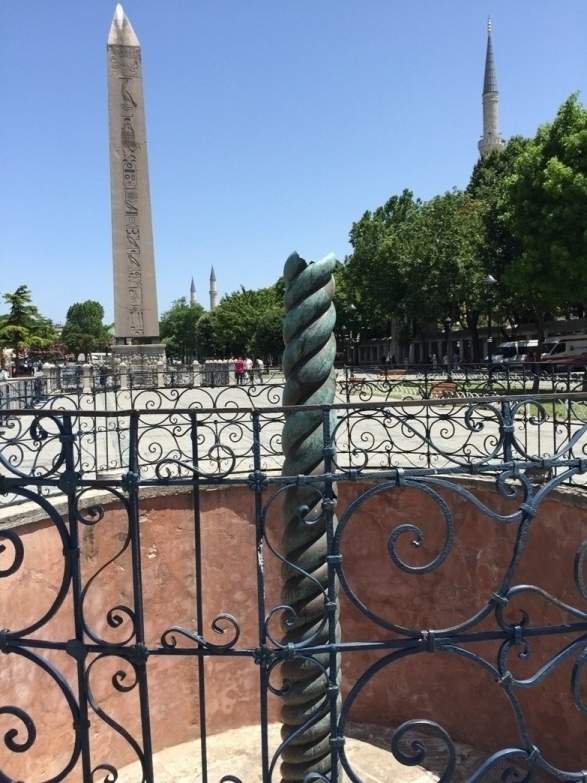 |
Egyptian Obelisk is originally one of the two obelisks that had been erected in the name of Thutmose III in front of Amon-Ra Temple in Karnak, Egypt, in the 15th century BC. Though it is 19.60 m / 64.30 ft today it is only the two thirds of the original one, which was either broken during the transportation or intentionally cut to make the shipment easier. It was sent to Theodosius by the Roman Governor of Alexandria in 390 AD.
The Obelisk is situated on a Byzantine marble base that gives some details about the Emperor from the Kathisma (Seat) and the races held at the Hippodrome. Emperor Theodosius is depicted on four sides of the base.
German Fountain was built piece by piece in Germany and then assembled in Istanbul to commemorate the second visit of Kaiser (also Prussian King) Wilhelm II to Istanbul in 1898.
Topkapı Palace (Museum)
The construction of the second palace of the Ottoman Empire began in 1459 and completed in 1478, though more additions were made by different sultans in the following years and centuries. The palace housed 25 Ottoman Sultans from Sultan Mehmet II to Sultan Abdülmecit. The palace was turned into a museum in 1924.
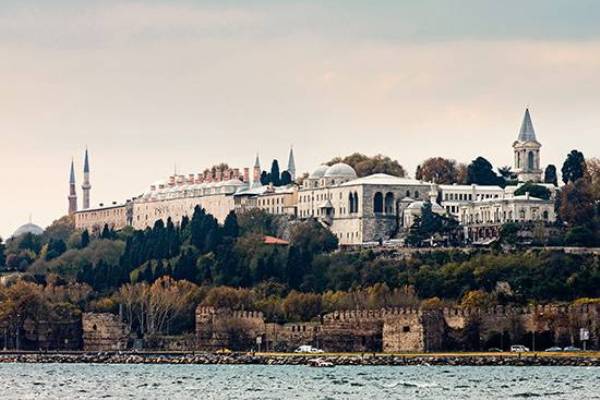
There are four courtyards with the following edifices:
First Courtyard
Bab-ı Hümayun (Imperial Gate)
Hagia Eirene
Imperial Mint
Archaeological Museum
Tiled Pavillion
Bab-üs Selam (Gate of Salutation)
Second Courtyard
Beşir Ağa Mosque
Privy Stables
Harem
Imperial Council Hall
Tower of Justice
Weapons and Armory
Bab-üs Saade (Gate of Felicity)
Kitchens
Third Courtyard
Library of Sultan Ahmet III
Sultan’s Costumes
The Treasury
Dormitories
The Holy Relics
Miniatures and Sultans’ Portraits
Fourth Courtyard
Revan Pavillion
Circumcision Room
Baghdat Pavillion
Mustafa Paşa Pavillion
Mecidiye Pavillion
The Bibliography
Bayraktar, Nimet; The Principal Mosques of Turkey, Istanbul: Galeri Minyatür
Nomiku, H. A. (1997), Haçlı Seferleri, Istanbul: Iletişim Yayınları
Sumner-Boyd, Hilary; Freely, John (1977), Istanbul: A Brief Guide to the City, Istanbul: Redhouse Press
Yenen, Şerif (2013), Istanbul, Istanbul: Yenen Travel Publishing

